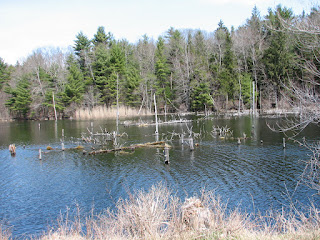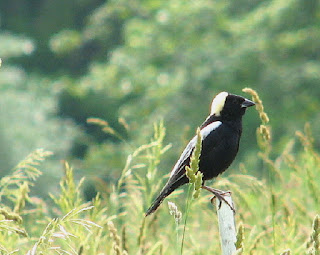
I started birding at 6am today. It seems to me, getting an early start usually pays dividends. My plan for today was to survey some of my favorite local birding spots (at least the ones that weren't flooded).
My first stop was the Old Marlboro Turnpike Power Lines. It was about this time that I had seen Prairie Warblers there last year. Unfortunately, there were no Prairie Warblers today. I was surprised when I saw a WHITE-TAILED DEER and a WILD TURKEY at the top of the hill. They seemed to be having a private conference.
There was also about 6 or so EASTERN TOWHEES singing- drink your tea-. I was fooled by one towhee that was calling out a single note. It was raspy sounding, so I thought it might be a Tanager.
After leaving the power lines, I drove a short way up the road to The Portland Reservoir.
The first thing I noticed was the CHIPPING SPARROWS. There was so many of them that I was hesitant to open my mouth in fear that one might fly in. I took a walk along the reservoir enjoying views of BELTED KINGFISHERS, BALTIMORE ORIOLES, and TREE SWALLOWS along the way.
At the end of the reservoir, there is a stand of pines on the left. It was here that I heard the little tin horn call of the Red-Breasted Nuthatch. I spotted the bird picking at a stump on the ground, but it flew further in to the woods before I took a picture. In this same area, there was a BLUE-HEADED VIREO, PINE WARBLERS, and BLACK-THROATED GREEN WARBLERS. The BT-Green has an easy to remember song which can be found here.
My last stop of the day was at the Portland Riverfront Trail. As I passed by the flooded field, I noticed some water birds on the far end. They looked very strange to me through the binoculars. I had forgotten to take my field guide, so I started to make primitive sketches. I took a photo that could be used for i.d. purposes. I recognized one of the birds as an AMERICAN WIGEON.
I moved a few feet up the path and saw my first BLACK AND WHITE WARBLER of the year. There was another warbler in the area that was making a strange buzzy song that was unfamiliar to me. It was similar in tone to a Blue-Winged Warbler's bee-buzz song, but the notes had a totally different pattern. I could not get a good look at this bird, and it was driving me crazy. I followed it for 30 minutes before finally, it showed itself. What was it?
It was a BLUE-WINGED WARBLER of course! I wasn't aware they had an alternate song. Not once did it bee-buzz me. Where was this bird's consideration?
I also saw my first HOUSE WREN, BLUE-GREY GNATCATCHERS, and an EASTERN COTTONTAIL RABBIT.
When I returned home, I searched my field guides to determine the identity of the water birds I had seen earlier. It turns out they were BLUE-WINGED TEAL. I had never seen them before, and they did not look the way that I had envisioned them. I have seen Green-winged Teal which seem to match their name in appearance. Today was one of those days that I learned a few things.
1)Do you remember being excited about figuring out a new species or learning one of its songs?
2)-Can you think of a caption for the Deer and Turkey Photo?




 This Hawk had an unwelcome passenger.
This Hawk had an unwelcome passenger.







 YELLOW-RUMPED WARBLER
YELLOW-RUMPED WARBLER

 Hey Mr. Mallard-can you find my car keys for me? I dropped them in the water. "No problem-bottoms up." After he gave me my keys back it was time to go.
Hey Mr. Mallard-can you find my car keys for me? I dropped them in the water. "No problem-bottoms up." After he gave me my keys back it was time to go.
 I took a ride over to Portland Reservoir. It consists of a dam, stream, reservoir(obviously),and a nice little bog-pictured above. There were lots of Tree Swallows flying about(they show beautiful color in bright sunlight), but I was not able to get a close-up picture of them.
I took a ride over to Portland Reservoir. It consists of a dam, stream, reservoir(obviously),and a nice little bog-pictured above. There were lots of Tree Swallows flying about(they show beautiful color in bright sunlight), but I was not able to get a close-up picture of them.


 Here's is a view looking down on a field that I visit throughout the year. I often find Brown Thrasher in the field as they sometimes nest here. Can you see the Sycamore tree in the distance?- Birds singing in the Sycamore Tree........
Here's is a view looking down on a field that I visit throughout the year. I often find Brown Thrasher in the field as they sometimes nest here. Can you see the Sycamore tree in the distance?- Birds singing in the Sycamore Tree........ Here is a Brown Thrasher that I saw singing in the top of the very same Sycamore tree last spring. Brown Thrashers usually sing a song twice in a row before switching to another. They make themselves very noticeable in the spring, but become very secretive in the summer.
Here is a Brown Thrasher that I saw singing in the top of the very same Sycamore tree last spring. Brown Thrashers usually sing a song twice in a row before switching to another. They make themselves very noticeable in the spring, but become very secretive in the summer. This horse is friendly. There is a black horse that will run toward me when I get in his field. I have to ease my way in and walk way around him. This picture of the horse was taken a week ago. It is grazing only about ten feet from that Sycamore tree. What a difference a week makes!
This horse is friendly. There is a black horse that will run toward me when I get in his field. I have to ease my way in and walk way around him. This picture of the horse was taken a week ago. It is grazing only about ten feet from that Sycamore tree. What a difference a week makes!






 This is an interesting looking abandoned building on the grounds next to the park.
This is an interesting looking abandoned building on the grounds next to the park.








 Mr. and Mrs. Cardinal took turns on the feeder tonight. It looks like the male Cardinal might be impressed with the reflection of his own handsome image.
Mr. and Mrs. Cardinal took turns on the feeder tonight. It looks like the male Cardinal might be impressed with the reflection of his own handsome image.


